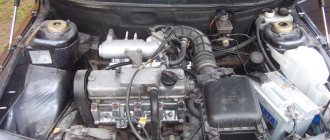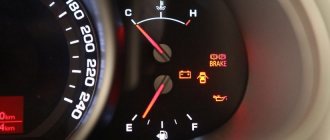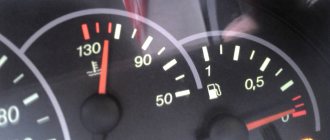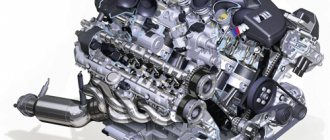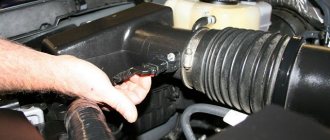Design of the Priora internal combustion engine cooling system
Below in the picture you can see a diagram of the engine cooling on a Priora with a description of its components.
The cooling system includes the following elements:
- Cooling radiator;
- Water pump (pump);
- Thermostat;
- Interior heater;
- Expansion tank and its cover;
- Cooling Fan;
- ICE shirt;
- Pipes;
All these details seriously affect the operation of the SOD, namely its effectiveness. Failure or improper operation of one of the parts can lead to malfunctions in the operation of the internal combustion engine and its overheating.
DTOZH for the pointer on the instrument panel
The operating principle of this sensor is to change the resistance when the internal element heats up. Passing through the indicator on the instrument panel, the current flows through a single wire to the device. And here the principle of induction in coils comes into play. Simply put, the higher the resistance, the more the needle on the indicator rises, due to the circulating currents in the coil located inside the indicator.
Possible malfunctions of the Priora coolant temperature display system
Most motorists, having discovered that the engine temperature gauge needle does not rise, believe that it is necessary to change the sensor. However, you should first make sure that this is the case. After all, there are several reasons for this state of the panel:
- Failure of the pointer on the instrument board.
- Break in the wiring.
- Direct failure of the sensor.
Therefore, it is better to conduct a small check on your own.
Location and serviceability check of DTOZH
This device is located directly above the Priora flywheel housing. The sensor is embedded in the engine block near the thermostat. It is connected to a single wire with a female connector. The test method for this device is very simple. And it has been used by drivers for a very long time. You need to do this:
- Turn on the ignition.
- Disconnect the connector from the sensor.
- Connect the wire to the block body.
If the DTOZH itself is faulty, the indicator arrow will rise to its highest position. But if no changes occur on the instrument panel, then the reason must be looked for elsewhere. Maybe the circuit is broken, the pointer is broken, or the whole combination.
How to replace the Priora coolant temperature sensor
This is a fairly simple operation. It is available to any driver.
Important! Many believe that this requires draining the coolant. But this is not necessary if you act quickly and skillfully. Otherwise, it’s better to drain it anyway. So. Just in case, drain the antifreeze. To do this, unscrew the cap in the radiator. It is located near the generator, below. And a plug-bolt in the engine block. First place the container under the bottom.
To access the right place, it is better to dismantle the air filter. Then the work area will be completely accessible. Prepare a new temperature sensor.
Using a 21 key, unscrew the old one and quickly screw the new one into place. Pour in antifreeze, making sure that no air pockets form. Replace the filter and start the engine. Wait for the fan to operate. At this time, watch the arrow. When you turn on the ignition, it should rise by 2-3 millimeters. And then, according to the degree of heating, smoothly enter the working zone of 92-98 degrees. If this is what happened, then the operation to replace the coolant temperature sensor for the Priora instrument panel can be considered successfully completed.
Useful video on this topic.
- How to replace the ECU coolant sensor on a LADA Priora car
- What is the outer CV joint of the Chery-Amulet car?
- How to change the CV joint boot on a Daewoo Nexia car
- How to change the CV joint boot on a Lanos
The coolant temperature sensor (CTS) in a Priora car performs the function of monitoring the thermal state of the power unit. Thanks to DTOZH, the driver always knows to what temperature the engine is warmed up and whether there is overheating in the system. You can learn more about the principle of operation, as well as replacing the controller, from this material.
Reasons why Priora overheats
There can be many reasons for overheating, but they are all of the same type and finding the cause of this illness is quite simple.
Cooling radiator
This part serves to cool the liquid, which, passing through the radiator, is cooled by a counter flow of air and then enters the engine, cooling it. When a radiator becomes dirty or damaged due to an impact, its tubes become bent, preventing the free flow of fluid through the system, thereby preventing the fluid from cooling to the required temperature. Due to this problem, overheating of the internal combustion engine is possible.
The problem can be solved by replacing the radiator with a new one, or by flushing it.
water pump
The water pump is used to help circulate coolant through the system. The pump is a part with a gear, shaft, housing, impeller and bearings. Quite often on a Priora it happens that the impeller on the pump breaks or turns, and this leads to the impossibility of antifreeze circulating through the system and, consequently, to overheating of the internal combustion engine.
The problem is solved by replacing the pump with a new one.
Thermostat
To limit engine cooling and maintain its optimal temperature, a special thermostat valve is used. It stops the circulation of fluid through the radiator, thereby heating the engine to operating temperature; as soon as the optimal temperature is reached, the thermostat opens and allows fluid to flow through the cooling radiator.
It happens that the thermostat gets stuck in the closed position and this leads to overheating of the motor. It is quite simple to determine this malfunction; you just need to touch the lower radiator pipe; it should be hot; if it is colder than all the others, it means that the thermostat is jammed and must be replaced.
Cooling Fan
To cool the engine of a car sitting in a traffic jam, a special fan is used, which simulates the flow of air encountered and cools the radiator. If this part fails, then there will be no cooling of the engine in the plug, which will lead to overheating of the engine.
If the engine cooling fan does not turn on, you need to check the temperature sensor, fuse and power connector.
Engine pipes
After any repairs, some pipes may sometimes become bent, which will lead to the cessation of fluid circulation through the system and overheating of the internal combustion engine. If the Priora is heating up, then it is necessary to check the pipes for integrity and compression.
Reasons why the engine may overheat
The cooling system, which can be filled with antifreeze, antifreeze or plain water, protects the internal combustion engine from overheating.
The main devices that monitor operating temperature and reduce it are:
A malfunction in any of the above components can lead to overheating. In addition to malfunctions of the above devices, overheating can be caused by both external factors and other internal faults.
External overheating
If symptoms of overheating appear, it is necessary to carry out an external inspection of the radiator, motor and cooling system.
The main causes of external overheating:
Internal overheating
There are many reasons for internal overheating, and not all of them can be detected visually, and some will have to be looked for by a qualified car mechanic.
Causes of internal combustion engine overheating:
Priora engine overheating. How to fix?
When the engine is running, a properly functioning cooling system maintains optimal temperature conditions. Malfunctions in the cooling system can lead to engine overheating.
If you miss this moment, unpleasant consequences may arise: breakdown of the head gasket, warping of the head and, as a result, complex and expensive engine repairs.
The instrument cluster of any car has a coolant temperature indicator. If the engine overheats, the gauge needle approaches the red zone.
How to check the cooling system
At the first signs of overheating, if the temperature gauge needle has gone into the red zone, but no clouds of steam are escaping from under the hood, turn on the maximum interior heating mode. This is necessary in order to reduce the temperature of the coolant in the engine cooling system.
Turn on the hazard lights, depress the clutch pedal and, using the inertia of the car, try to carefully move to the edge of the roadway and stop as far to the right as possible on the side of the road, and if possible, outside the roadway. Let the engine run for a couple of minutes at normal idle speed with the heater on full blast.
Do not stop the engine immediately! The only condition is to maintain the tightness of the cooling system. If the hose bursts or comes off, or another leak occurs other than fluid escaping from under the expansion tank plug, the engine will have to be stopped immediately!
After stopping the overheated engine, local overheating of the coolant begins at the points of contact with the most heat-stressed engine parts and the formation of vapor locks. This phenomenon is called heat stroke.
Note that on our website there is already a publication about replacing the radiator of the cooling system on a Lada Priora with your own hands.
2. Open the hood and inspect the engine compartment. Determine where the steam is coming from. When inspecting the engine, pay attention to the presence of coolant in the expansion tank, the integrity of the rubber hoses, radiator, and thermostat.
Never open the expansion tank cap immediately. The liquid in the cooling system is under pressure; when the plug is opened, the pressure will drop sharply, the liquid will boil and its splashes can scald you. If you want to open the expansion tank cap on a hot engine, first place a thick thick rag on top and only then carefully unscrew the cap.
The valve of the expansion tank plug plays a major role in ensuring optimal temperature conditions. It maintains an excess pressure in the system of at least 0.1 MPa (1.1 kgf/cm2). In this case, the boiling point of water increases to 120 °C, and the coolant - to 130 °C. Unfortunately, when the valve jams in the closed position due to overheating, a significant excess of excess pressure occurs - more than 0.2 MPa (2 kgf/cm2), which can lead to rupture of the expansion tank or failure of one of the hoses.
How much does engine No. 126 cost?
As it turns out, buying a new 16-valve unit for a Lada Priora is an expensive proposition. Today you can purchase a 16 valve 1.6 liter EURO-3 and EURO-4 engine. The first option costs approximately 102 thousand rubles, and the second – 103 thousand. Motorists are also interested in how much it costs to purchase a used Lada unit. Used ones can be purchased even for 20 thousand rubles. But you can find out what condition this unit is in only after a complete disassembly or a trip to a car service center. The average price for a used one is 50-60 thousand rubles.
Priora heats up at idle
Good afternoon. I want to share useful information with you. Recently I had the following problem: I noticed that while driving, the coolant temperature began to rise to 100-110 degrees. The coolant cooled down when driving at idle. and when releasing the gas while driving (on the highway downhill without turning off the gear). For a couple of days while I was looking for the cause, I rode with the fan constantly running (I removed the chip from the sensor on the thermostat), it helped a little, but the temperature was still over 90.
What was done. First of all, I checked with diagnostics that the coolant temperature readings on the dashboard were correct, the temperature was on. fans. Everything is okay. After warming up the lower radiator pipe at around 85 degrees, I realized that the thermostat was opening on time, but just in case, I replaced it (I thought that it might not open completely and that could be the reason for poor coolant circulation). Did not help. I cleaned the radiator with a Karcher. Did not help. All that remained was the pump, radiator, expansion cap and, as an option, the block gasket. Since gases were not expelled into the expansion tank, I decided that the gasket was intact. Then he removed the thin hose on the expansion tank, lowered it into the neck, started the car and began to watch how the coolant stream behaves. On H.H. Everything is normal, I add gas, the pressure increases and begins to weaken and becomes weaker than at H.H. ... Is it really a pump? By the way, I changed it along with the timing kit 16,000 km. back.
I took everything apart, took off the belt, turned the pump by the pulley - there was no play, no extraneous noise either... I decided to remove and check the impeller... And this is the actual reason!
I bought it from AUTOPASKER. The box corresponded to all the authentication information, even sent an SMS, everything was confirmed. BUT now I understand that she was LEFT
Photo of the boxes. LEFT - LEFT, RIGHT factory in new packaging. Purchased from "SUV"
There was no way to take a photo of the new pump, so I took it from the net.
The top one is the original, my bottom one is the leftist one.
There are no markings on the left side, the original has a mark or some numbers. There are more holes on the left. And most importantly, on the left, the blades are bent in the other direction. When I changed the pump for the first time, there was nothing to compare it with, since I had one from the factory with these blades.
“The best teacher is experience; he explains clearly, but charges dearly.”
Friends, be vigilant, check everything a hundred times, this will save your time, money and nerves.
When the engine is running, a properly functioning cooling system maintains optimal temperature conditions. Malfunctions in the cooling system can lead to engine overheating.
Consequences of mild, moderate and severe overheating
The consequences and cost of repairs depend on the degree of overheating of the internal combustion engine. Timely maintenance of the car, monitoring the coolant level and temperature conditions when driving reduces the occurrence of overheating significantly.
Slight overheating of the internal combustion engine occurs when the engine operates at a temperature exceeding the temperature for 4-12 minutes. This mainly occurs when the thermostat or fan malfunctions, and the driver detects this in a timely manner and takes action.
In many cases, such a situation, if it occurs once, does not affect the condition of the engine, especially if it has a short mileage. The pistons often melt slightly; when the temperature rises significantly, even for a short time, dark-colored smoke appears from the muffler, and there is a feeling that the engine is constantly running under load.
Even after a single short-term overheating of the engine, it will subsequently begin to heat up more often due to changes in the pistons and the remaining melted metal in the cylinders.
The average degree of overheating of the internal combustion engine appears when the engine is running at extreme temperatures for at least 20 minutes. There are many reasons for this situation and they have all been described earlier.
The consequences of such overheating are already more tragic. In addition to the consequences characteristic of mild overheating, which manifest themselves to a greater extent, there are added skew of the cylinder head or the appearance of cracks in it, burnout of cylinder head gaskets, ejection of the valve seat, severe deformation of the pistons, destruction of the inter-ring partitions of the pistons, oil leakage from under all kinds of gaskets and seals .
Severe overheating of the internal combustion engine causes all sorts of very serious consequences. In this case, individual working units may survive or the engine can be thrown out.
The main consequences of excessive engine overheating:
Device and features
The cooling system of the Priora internal combustion engine has a standard set of main components:
- radiator;
- thermostat;
- electric fan;
- water pump;
- heater;
- engine jacket;
- connecting hoses;
- expansion tank.
By circulating through the large and small circuits, the coolant prevents the engine from overheating, maintaining the desired temperature. Structurally, the cooling system of the Priora is simple and no different from other internal combustion engines with an injector, with the exception of small parts.
Radiator and forced cooling fan
They mainly serve to bring the working fluid to the optimal temperature for the functioning of the engine (the operating temperature of the Priora engine with 16 valves is 90–95 degrees). The predecessor of the Priora VAZ 2110 often installed a cooler made of copper alloys, but due to cheaper prices, designers switched to aluminum analogues.
The operation of the fan depends on the engine control unit.
It receives information from the DTOZH (this is a sensor that reads temperature readings) located in the water jacket of the power unit. If the permissible temperature values are exceeded, the control unit connects an electric fan to improve cooling efficiency. A faulty fan or clogged radiator can lead to a constant increase in optimal engine temperatures, which shortens the service life and can cause costly repairs.
Thermostat
Its task is to promptly open coolant access to a large circle of the engine cooling system (engine cooling system) after the engine reaches the optimal temperature. In simple terms, the thermostat allows you to quickly warm up the engine and regulates the operation of the entire system. During warming up, the thermostat valve is in the closed position, antifreeze does not flow through the large circuit (the radiator is not activated). As it warms up, the valve opens slightly under the influence of rising temperature, and antifreeze begins to move through the radiator along a larger circuit.
A thermostat malfunction can result in overheating of the power unit (if the valve is stuck closed) or, conversely, the operating temperature rises very slowly (when the valve is stuck in the open position). Overheating is much more dangerous. Beginners can identify this malfunction if the engine heats up all the time and the fan on the Priora is constantly running.
Pump (water pump) and heater
Without the first part, the coolant circulation circuit in the system is impossible. If the water pump is faulty, at best there will be a coolant leak from the system. In the worst case, the pump may jam, which will lead to a broken timing belt and subsequent problems, the solution of which will result in expensive repairs.
The heater, or simply the stove, consists of a radiator, pipes and a fan. Can additionally cool the antifreeze in the system. An indispensable unit in winter. Provides the interior with warm air.
Connecting elements and expansion tank
It serves as a receiving compartment where gases and vapors are discharged when the coolant is heated. Also, the expansion tank is the level for the entire cooling system. One of the main elements in the tank is the valve cover through which air is forced out. There is antifreeze, it begins to boil when the engine temperature rises critically.
The connecting hoses serve as a pipeline for the circulation of coolant and connecting elements of all structural units, thus creating a single looped and sealed circuit.
The design of the cooling system also includes an engine temperature sensor on the Priora and an engine jacket. The sensor constantly reads information about the current antifreeze temperature and transmits it to the ECU. The location of the power plant jacket is structurally assumed in the cylinder block housing; it serves to remove heat through the coolant.
Engine operating temperature
We have learned the resource, now we move on to another important indicator. The optimal operating temperature is 90-95°C. After 97°C, engine number 126 with 16 valves will “slow down” a little, but according to the rules, temperatures up to 100°C are considered normal. If the Lada unit is operated with this indicator, then you need to be sure that the radiator fan is running at this time. When you see an indicator below +90°C on the dashboard, you need to assume that this is underheating. Of course, in cold weather the power plant needs more time for the temperature to reach normal levels.
- Operating temperature – 90-95°C.
- Normal temperature (engine runs worse) is 97-110°C.
- Reduced temperature – 90°C and below.
Bad thermostat
In hot weather, this element can also affect engine overheating. If there is a malfunction of the thermostat, the engine begins to heat up longer, and while on the road it constantly increases its operating temperature. Therefore, if the engine heats up at speed, most likely the cause is the thermostat. A low-quality part may simply jam. As a result, the half-open element is unable to ensure normal heat exchange and circulation of coolant at high speed. The way out of the situation is similar to the first case - the faulty element must be replaced. By the way, many owners of domestic cars in the summer simply remove the thermostat and drive without it. The engine of such cars does not heat up throughout the hot season. Well, with the onset of autumn, motorists again install this element in its regular place.
Note that the engine does not always heat up due to the thermostat. Perhaps the reason for this may be the lack of coolant in the system (we'll talk about this a little later). Therefore, the thermostat is always tested for functionality before replacement.
Rated operating temperature of the VAZ 21126 Priora engine
To find out what the normal operating temperature is in the Priora 16 class injection engine, just study the factory technical documentation. It says that according to the International Motor Vehicle Manufacturers Convention, the operating temperature in gasoline engines with an injection power system should be within 90 degrees. Specifically, the Priora VAZ 21126 engine must operate in the temperature range from 87 to 103 degrees.
Temperature sensor Lada Priora
This contributes to the normal correct operation of the power system, maximum engine performance, and in addition, the content of harmful substances in the exhaust gases complies with Euro3 standards that were current at that time. And the engine power, as practice shows, remains within the nameplate limits - about 98 forces at 5.5-5.6 thousand rpm. Again, judging by the reviews, and based on practice, fuel consumption during overheating can increase by 15-25%, and when operating the engine at coolant temperatures below 85 degrees, consumption increases by 10-18%.
Features of cooling system malfunctions
The efficiency of the structure primarily depends on the level of antifreeze in the system and its condition (this liquid has a certain resource, usually up to three years or up to 50,000 km). The main sources of system malfunctions are the thermostat, radiator and electric fan, as well as the water pump, the principle of operation of which is described above.
The radiator most often becomes the source of antifreeze leakage. Accordingly, the liquid level in the system drops, and there is not enough of it for effective heat removal. The motor begins to overheat. It can also be clogged with garbage. And if water is used instead of antifreeze the old fashioned way, scale may form.
The consequences of a faulty water pump are much more serious. In addition to antifreeze leakage, the circulation of coolant in the system may stop and, as a result, the engine will quickly overheat. The worst case scenario is bent valves due to a broken timing belt.
The next common malfunction is burnout of the cylinder head gasket or deformation of the cylinder head of the internal combustion engine system. This leads to coolant entering the fuel combustion chambers. The same thing can happen if cracks appear on the cylinder block.
Coolant leakage is most often associated with loss of tightness of the connecting pipes, because over time, the material from which they are made hardens and wears out, as a result of which it cannot work properly.
On a Priora, a lot depends on the computer, and a faulty coolant temperature sensor can give incorrect readings. For example, if the ECU receives underestimated performance, the engine will begin to overheat. Otherwise, the fan will be constantly on. On the other hand, often the cooling system sensor does not transmit any readings at all. Then the ECU switches the operation to emergency mode.
Are the valves bent?
Each engine in a Lada Priora car bends a valve, this also applies to the most powerful unit number 126 by 16. They will tell you this in any service center that services domestic cars. But novice drivers should know that the engine bends components for a reason, and if you follow the operating rules, you will not encounter this problem.
The Lada power plant bends parts only if the routine work to replace the belt and other components of the gas distribution mechanism (GRM) is violated. The motor bends the valve if the rollers, belt or water pump were not replaced in time. When one of these elements breaks, the number 126 pistons meet the valves. Due to this design feature, the motor bends the parts. The solution to the problem is a major overhaul of the Lada.
So, the task of the owner of a Lada Priora with engine number 126 for 16 cl is to check the timing belt in a timely manner.
The condition of the belt should be checked every 50 thousand kilometers (according to the factory recommendations - 100 thousand) - there should be no cracks, delaminations, or breaks on it. If they are present, the belt must be changed urgently. Mandatory repairs take place after 200 thousand kilometers.
The rollers and timing pump number 126 should also be given attention when inspecting the belt. After all, the engine bends parts even with faulty rollers. Sometimes the timing belt and its components wear out prematurely - you will know this by vibrations from the engine compartment and an unpleasant grinding noise. Engine number 126 bends the valve, so do not forget to change the timing components in time and repair this unit.
Replacing elements
Structurally, the Lada Priora engine cooling system has a simple design. Therefore, we will consider replacing only individual components, with which certain difficulties are possible, especially for beginners.
Replacing the cooling system radiator
This unit on cars rarely changes. Typically, this procedure is necessary when a leak occurs that cannot be eliminated. Its service life can be 10 years or more. Cases when replacing the radiator are simply necessary are as follows:
What to do if the engine has already started to overheat
If overheating has begun or is suspected, it is necessary to take immediate action to avoid serious problems with the engine in the future.
If the needle has just entered the red zone (overheating zone), then you can turn off the engine, but it is advisable to cool it a little by turning it on to the maximum temperature and blowing on the stove.
In any case, it is necessary to inspect the radiator and engine compartment. If there is liquid in the expansion tank, then you can cool the engine a little by turning on the heater fan to the maximum temperature and blowing mode.
If there is a complete absence of coolant in the tank, turning on the heater at maximum mode will not help cool the internal combustion engine, and may worsen the situation. In this case, it is necessary to turn off the engine and transport the car to the repair site using a tow truck.
If minor leaks are detected in the cooling system after the engine has cooled, it is possible to add water or coolants. Under no circumstances should you add any liquid to the expansion tank of a hot engine, since the difference in temperatures can lead to cracks in different components of the internal combustion engine or other consequences.
It is strictly forbidden to water the engine, since in this case its repair is inevitable due to the appearance of cracks in the cylinder block body.
An overheated engine is turned off only in certain cases: when steam appears from under the hood, indicating a significant leak in the cooling system, or a complete absence of coolant in the tank.
Even a slight overheating of the motor, at best, will lead to unpleasant consequences in the future, and significant overheating can almost completely destroy its insides, which will lead to the need to install another motor.
Such situations can be prevented; to do this, it is necessary to constantly monitor the coolant level, do not pour water into the cooling system, change the cooling pump and working fluids in a timely manner, regularly inspect the pipes for the appearance of cracks in them, and monitor the cleanliness of the radiator and engine housing.
Source
Flushing the cooling system of Lada Priora
It becomes dirty and clogged over time and intensity of use. Clogged SOD channels do not allow antifreeze to circulate freely, as a result, heat transfer is disrupted. The stove in the cabin begins to heat poorly, and meanwhile the engine constantly overheats. In these situations, the right solution would be to clean the cooling system. To do this, first of all you need to cool the engine.
The following is the procedure.
- Drain the coolant (not only from the radiator, but also from the engine jacket, by unscrewing the drain plug on the cylinder block).
- Fill the expansion tank with any suitable flushing fluid to the optimum level.
- Start the engine and let it idle for at least 15 minutes.
- Drain the used fluid.
Then, if necessary, the procedure is repeated. After flushing, all that remains is to fill in fresh antifreeze and remove the air lock from the system. If a more thorough flushing of the system is required, then there is nothing complicated here either. To do this, you will need a regular watering hose connected to the water supply. To flush the radiator, you need to disconnect the lower and upper pipes, insert them into the upper hose and turn on the water. All dirt and rust will come out of the bottom. To flush the engine jacket, you need to do the same steps, but the hose is inserted into the thermostat pipe.
The effectiveness of flushing the system largely depends on the product chosen as a flushing agent.
The simplest option is regular tap water. Add lemon juice to it. Carbonated drinks, such as cola, are also suitable. You can also buy special cleaning products for washing SOD in specialized stores.
If the fan does not turn on
If the RTD has risen to 100 degrees and the indicator needle has entered the red part of the scale, this indicates overheating. Perhaps this phenomenon occurred due to the fact that the fan did not work. If you find that when it overheats, the fan does not start working and the temperature does not drop, you need to check the serviceability of the fan itself. It is necessary to determine whether the switch-on sensor is triggered when the normal RTD is exceeded? First, start the engine and disconnect the wires from the temperature sensor that is installed on the engine. When the wires are disconnected, forced cooling should work. If this does not happen, most likely the fault lies in the electric motor of the device. How to check the operation of the fan, watch the video.
If the fan turns on after disconnecting the wires, it means there is a problem with the fan switch sensor. Perhaps it incorrectly perceives data about the RTD and therefore does not operate at the right time.
This malfunction is quite easy to fix: you just need to replace the sensor. After replacing it, check if the fan turns on. To do this, start the engine. When the RTD reaches normal levels, do not turn off the engine until the temperature exceeds the norm. As soon as this happens, the fan should be activated. If the fan operates at a temperature above 97 degrees, but less than 100 degrees, then the system is functioning properly.
Why does the engine on a VAZ-2112 16 valves get hot: reasons, photos
Every car owner was faced with the fact that the 16-valve VAZ-2112 engine began to heat up. If you look at the dashboard indicator, the arrow tends to the red zone, and liquid boils in the expansion tank - this means that there is a malfunction in the cooling system.
Causes of engine overheating
The temperature indicator needle has entered the red zone, which means the engine is overheating
Many car enthusiasts remember the reasons for the effect on old Zhiguli cars. On 16-valve engines, the reasons for this effect are almost the same. Let's consider what reasons may cause the main power unit to begin to overheat:
All these problems can cause the engine to overheat.
Elimination methods
To eliminate the causes of engine heating, it is necessary to establish the epicenter of the effect. To do this, it is worth checking each node sequentially. After identifying the problem, it is worth finding the exact cause and eliminating it. So, let's consider the sequence of actions.
Engine cooling system diagram
Radiator and pipes
One of the reasons for engine overheating may be that the radiator and pipes become clogged, which affects the circulation of fluid in the system, and can also lead to cracks in the pipes and breakdown of the radiator, which will lead to leakage of coolant.
If there is insufficient coolant in the system, the power unit will heat up faster and take a long time to cool down, and the cooling fan will run almost continuously.
Radiator and cooling system pipes
The method for solving the problem is quite simple - dismantling the radiator from the system and cleaning it both outside and inside.
The second stage will be to inspect the pipes for leaks and replace worn-out products. As practice shows, many motorists install kit kits (tuning versions) of the radiator and pipes to extend the service life of the cooling system.
Pump (water pump)
One of the main reasons for overheating is that there is backlash in the water pump . It is quite easy to determine this malfunction, because a corresponding howl appears in the pump area. Also, a sign of a malfunction may be that liquid begins to leak from the pump shaft. The problem can be fixed quite easily by replacing the water pump.
Engine mounted water pump
Cooling sensor
The cooling temperature sensor is a harmless breakdown that can lead to the indicator on the instrument panel showing incorrect data, so the driver will not even know that the engine has overheated until it boils on the road.
Typically, this malfunction is accompanied by many associated factors, so it is quite difficult to miss it. There is only one solution to the problem - replacing the cooling system sensor and resetting errors that occurred in the ECU.
Fan
The last cause of overheating, especially in the summer, is the cooling system fan.
The fan under the hood is indicated by an arrow
So, a breakdown of this unit can cause the engine to overheat and the coolant in the expansion tank to boil.
In this case, the consequences can be very diverse, well, you need to check the fan for serviceability, as well as the sensor for turning it on - that’s for sure. This part fails quite rarely, and therefore the reason for the failure may be a simple fuse or a wiring fault, which can be easily fixed.
Consequences of untimely elimination of defects
Not all drivers realize what consequences can be caused by an engine overheating, and continue to drive with a constantly running fan or frequent overheating.
So, the consequences of strong engine heating are divided into 3 stages, which are worth considering separately.
Slight overheating
If the engine overheats for up to 10 minutes, the consequences may be minor. Thus, cracks will appear in the pipes of the cooling system, the temperature sensor will fail, the oil scraper rings will become deformed, and the valve and camshaft seals will melt. Also, the valves will burn out, and oil will enter the combustion chambers, which will be marked by the release of black smoke from the exhaust system.
Consequences of mild overheating, namely burnout of valves
Significant overheating
With significant overheating, deformation occurs, or rather deflection of the cylinder head. To eliminate these consequences, you will have to dismantle the cylinder head and submit it for surface grinding. Thus, it turns out that the block head is subject to major repairs.
Burnout of the piston group due to significant overheating Measuring the deflection of the cylinder head using a ruler
Severe overheating
With severe overheating, the walls of the cylinder block become deformed and burn out, causing melting of the piston group, deformation of the connecting rods, or even breakage of the crankshaft. Thus, the engine cannot be repaired, since usually the walls of the power unit collapse and their restoration is impossible.
Burnout and deformation of pistons after severe overheating Melting of the walls of the cylinder block after overheating
conclusions
The causes of heating and overheating of a 16-valve engine have been identified and methods of elimination have been discussed. Thus, untimely repair of this unit can lead to the fact that the engine will finally fail and will need to be replaced. Therefore, if the first signs appear that the cooling system has failed, it is necessary to find and eliminate the cause, since a replacement will be much more expensive.
